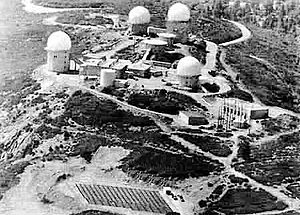ADTAC
| Air Defense, Tactical Air Command | |
|---|---|

87th Fighter-Interceptor Squadron F-106, AF Ser. No. 59-0094, from K.I. Sawyer AFB, Michigan, in flight in the early 1980s. Note the Tactical Air Command emblem on the tail
171st Fighter-Interceptor Squadron, Michigan ANG, F-16A Block 15 Air Defense Fighter, about 1985 |
|
| Active | 1 October 1979 – 6 December 1985 |
| Country | United States |
| Branch |
|
| Part of |
|
| Garrison/HQ | Langley AFB, Virginia |
| Insignia | |
| Emblem of Air Defense, Tactical Air Command (ADTAC) |  |

751st Radar Squadron, Mount Laguna Air Force Station, California, 1980
Air Defense, Tactical Air Command (ADTAC) was a Named Unit of the United States Air Force, and operated at the Numbered Air Force echelon of Tactical Air Command. It was responsible for the air defense of the United States, and was last stationed at Langley Air Force Base, Virginia. It was last assigned to Tactical Air Command, and was inactivated on 6 December 1985.
ADTAC was established when the Aerospace Defense Command (ADCOM) was inactivated as a Major Command on 1 October 1979. Aerospace Defense Command's atmospheric defense resources (interceptors, warning radars, and associated bases and personnel) were subsequently transferred to ADTAC. The command was, essentially, a transition organization between the Aerospace Defense Command, and the transfer of the air defense mission from the USAF to the Air National Guard in 1990.
It consisted of over 25,000 military and civilian personnel performing duty at radar sites, missile warning stations, fighter interceptor bases, satellite tracking centers, and command and control centers throughout the world. The command had the responsibility to provide operationally ready interceptor aircraft and aircrews for air defense alert 24 hours per day, 365 days per year. These assets had to be capable of scrambling to identify and assist or engage unidentified or hostile airborne objects approaching or entering United States airspace without proper approval. These scrambles were initiated from the respective region headquarters based on information derived from radar site data and previously known or expected airborne traffic. During increased states of readiness, these same ADTAC assets would provide additional air defense forces to CINCNORAD to provide early warning information, attack assessment, and air defense of North America. During peacetime operations, the mission of ADTAC was to command, train, manage, and evaluate forces required for the above-mentioned air defense contingencies. In doing so, the tasks of preparing budget proposals, acquiring equipment, and providing support requirements, were essential to providing ready air defense forces.
...
Wikipedia
